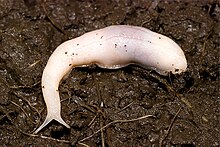Selenochlamys ysbryda
| Ghost slug Selenochlamys ysbryda | |
|---|---|

| |
| A live individual of Selenochlamys ysbryda, head end towards the lower left | |
| Scientific classification | |
| Kingdom: | |
| Phylum: | |
| Class: | |
| (unranked): | |
| Superfamily: | |
| Family: | |
| Subfamily: | |
| Genus: | |
| Species: | S. ysbryda
|
| Binomial name | |
| Selenochlamys ysbryda Rowson & Symondson, 2008[1]
| |
The ghost slug, Selenochlamys ysbryda, is a species of predatory air-breathing land slug. It is a shell-less pulmonate gastropod mollusc in the family Trigonochlamydidae.
The species was discovered in 2006 in Cardiff, Glamorgan, Wales[2] and was formally described and named in 2008 by Ben Rowson, a research assistant and PhD candidate at the National Museum Wales (Amgueddfa Cymru), and Bill Symondson, an ecologist at Cardiff University.[3]
In 2012 a single specimen of Selenochlamys cf. ysbryda was rediscovered in a collection made in 1989 from a natural mountain forest in the Crimea in the Ukraine.[4] Probably the Crimean mountains are within the native range of this species.[4]
Description and ecology
This slug can reach 6.4 cm (2.52 in) in size, with its body extended. It has no eyes, and is white in colour. It is nocturnal and burrowing, and unlike the majority of slugs, it is a carnivore, feeding on earthworms at night using its blade-like teeth.[5] Both the mantle and the breathing hole are found at the tail end of the body.[6] The species was unknown to science prior to 2006.[3]

Because of the slug's white colour and nocturnal habits, and because it has been so rarely seen, it was given the species name ysbryda, the word "ysbryd" meaning ghost in the Welsh language. This in turn gave rise to the common name, "ghost slug". This appears to be the first case of a species name having been taken from the Welsh language.
Distribution
Other slug species in this family are found in Turkey and Georgia,[3] but no representatives have been found and described in Western Europe prior to this discovery. Although the species is almost certainly introduced, its country of origin and how it made its way into Britain was unknown at the time of its original description. Bill Symondson speculated that the slug originally evolved in cave systems alien to the UK, and may possibly have arrived in Wales in soil in a potted plant.[3]
The first specimen was collected in the churchyard of Brecon cathedral on 29 December 2004, but its significance was overlooked at the time.[7] A second specimen was found in a lane in Caerphilly on 29 October 2006.[8] This single specimen was photographed and then released. A year later, another slug was found by a gardener near Cardiff, Wales, where it was brought to the attention of the National Museum Wales. Additional ghost slugs have been found in Gorseinon, near Swansea, Wales,[9] Hay-on-Wye (Welsh Borders), and Knowle, near Bristol, England.[10][11]
The slug is not harmful to humans, but as a presumed introduced species, more records from Britain are being solicited, partly on the basis of an appeal to the public. As more information is gathered, the distribution of the species will be monitored to check that it does not become an invasive pest species as it presumably spreads across South Wales.
In 2012, a specimen of what is probably the same species, Selenochlamys cf. ysbryda, was rediscovered in the Crimean mountains in the Ukraine.[4] A single immature specimen had been collected in a natural mountain forest in 1989. This is the first record of Trigonochlamydidae in the Crimea. This Crimean specimen differs from Selenochlamys pallida in the same way as does S. ysbryda, so probably it belongs to the latter species. Probably this slug is native to the Crimean Mountains and perhaps endemic there.[4]
Selenochlamys ysbryda was selected as one of "The Top 10 New Species" described in 2008 by The International Institute for Species Exploration at Arizona State University and an international committee of taxonomists.[12]
Etymology
The specific epithet ysbryda, is derived from Welsh ysbryd, meaning a ghost or spirit. The word was Latinized by the addition of a feminine ending a, and is to be treated as a noun in apposition. The name alludes to the species’ ghostly appearance, nocturnal, predatory behaviour and the element of mystery surrounding its origin.[2]
References
- ^ Rowson B. & Symondson O. C. (2008) "Selenochlamys ysbryda sp. nov. from Wales, UK: a Testacella-like slug new to western Europe (Stylommatophora: Trigonochlamydidae)". Journal of Conchology 39(5): 537-552. abstract.
- ^ a b "Welsh Rare Bit". International Institute for Species Exploration. Arizona State University. Retrieved 2012-10-29.
- ^ a b c d "'Ghost slug' is a mystery - New species of slug surfaces in the UK". National Museum Wales. 2008-07-10. Retrieved 2012-10-29.
- ^ a b c d Balashov I. 2012. Selenochlamys ysbryda in the Crimean Mountains, Ukraine: first record from its native range?. Journal of Conchology. 41 (2): 141-144.
- ^ Worm-eating slug found in garden (video), BBC News. Published 10th July, 2008. Retrieved 10th July, 2008.
- ^ Help us find out more about the mysterious alien "Ghost Slug"
- ^ Reise, H. & Hutchinson, J.M.C. 2009. An earlier record of the slug Selenochlamys ysbryda from Brecon, UK. Journal of Conchology 40:103. Published October 2009. Retrieved 4th December 2009.
- ^ Albino snail? (photos), The petsnails.co.uk forums. Published 29 October 2006. Retrieved 15 July 2008.
- ^ Help us find out more about the mysterious alien "Ghost Slug" Published 9 July 2008, Cited 7 October 2008.
- ^ Ghost slug update, spring 2010 Published 6 June 2010, Cited 11 May 2010.
- ^ Update to Reise & Hutchinson 2009
- ^ http://asunews.asu.edu/20090522_top10species
